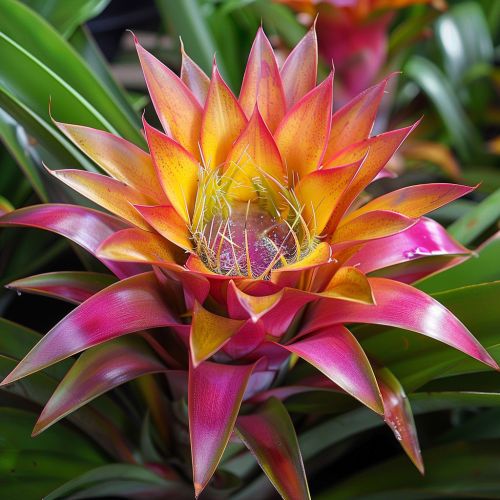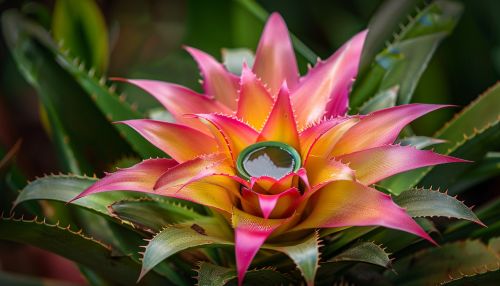Bromeliads
Introduction
Bromeliads are a family of monocot flowering plants known as Bromeliaceae. This diverse family includes over 3,000 species, distributed across 75 genera. Native primarily to the tropical Americas, bromeliads exhibit a wide range of forms and adaptations, making them a fascinating subject of study for botanists and horticulturists alike. The family includes well-known plants such as the pineapple (Ananas comosus) and Spanish moss (Tillandsia usneoides).
Taxonomy and Classification
The Bromeliaceae family is divided into three subfamilies: Bromelioideae, Tillandsioideae, and Pitcairnioideae. These subfamilies are distinguished by their morphological characteristics and ecological adaptations.
Bromelioideae
The Bromelioideae subfamily is characterized by its rosette-forming plants, which often have spiny leaves and brightly colored bracts. This subfamily includes popular genera such as Aechmea, Guzmania, and Neoregelia. Many Bromelioideae species are epiphytic, meaning they grow on other plants, but some are terrestrial.
Tillandsioideae
The Tillandsioideae subfamily includes the genus Tillandsia, which is known for its air plants. These plants are primarily epiphytic and absorb water and nutrients through their leaves rather than their roots. Tillandsioideae species often have trichomes, specialized cells that help them capture moisture from the air.
Pitcairnioideae
Pitcairnioideae is the most basal subfamily and includes both terrestrial and epiphytic species. This subfamily is less well-known but includes genera such as Pitcairnia and Dyckia. Pitcairnioideae species often have tough, spiny leaves and are adapted to arid environments.
Morphology
Bromeliads exhibit a wide range of morphological diversity, but they share some common features. Most bromeliads have a rosette of leaves that form a central tank or cup, which collects water and organic debris. This tank provides a habitat for various microorganisms and small animals, creating a mini-ecosystem.
Leaves
The leaves of bromeliads are typically tough and leathery, often with spines along the edges. They can be green, variegated, or brightly colored, depending on the species. The leaves are arranged in a spiral pattern, which helps channel water into the central tank.
Flowers
Bromeliad flowers are usually small but can be quite showy, especially when accompanied by brightly colored bracts. The flowers are often tubular and can be pollinated by a variety of animals, including birds, bats, and insects. Some bromeliads produce flowers that last only a few days, while others can bloom for several months.


Roots
The roots of bromeliads are primarily used for anchorage rather than nutrient absorption. Epiphytic bromeliads have minimal root systems, while terrestrial species have more developed roots. In some species, the roots can also absorb moisture and nutrients.
Ecology and Habitat
Bromeliads are found in a wide range of habitats, from rainforests to deserts. Their ability to adapt to different environments is one of the reasons for their diversity.
Epiphytic Bromeliads
Epiphytic bromeliads grow on other plants, usually trees, without harming their hosts. They are common in tropical rainforests, where they can receive plenty of light and moisture. These plants have specialized adaptations, such as trichomes, to capture water and nutrients from the air.
Terrestrial Bromeliads
Terrestrial bromeliads grow in soil and are often found in more arid environments. They have more developed root systems and are adapted to withstand periods of drought. Some terrestrial species, like Puya raimondii, can grow to be quite large and produce impressive flower spikes.
Reproduction and Life Cycle
Bromeliads have a unique reproductive strategy that involves both sexual and asexual reproduction.
Sexual Reproduction
Sexual reproduction in bromeliads involves the production of flowers and seeds. The flowers are often pollinated by animals, and the seeds are dispersed by wind, water, or animals. After flowering, many bromeliads produce offsets, or "pups," which are clones of the parent plant.
Asexual Reproduction
Asexual reproduction occurs through the production of offsets. These pups can be separated from the parent plant and grown independently. This form of reproduction allows bromeliads to colonize new areas quickly.
Uses and Cultivation
Bromeliads are popular in horticulture due to their striking appearance and relatively low maintenance requirements. They are used in both indoor and outdoor gardens and can be grown in pots, mounted on boards, or even hung in the air.
Ornamental Uses
Many bromeliads are grown for their ornamental value. Species like Guzmania lingulata and Neoregelia carolinae are prized for their colorful foliage and long-lasting flowers. Bromeliads are often used in tropical-themed gardens and as houseplants.
Agricultural Uses
The most well-known agricultural bromeliad is the pineapple. Pineapples are grown commercially in tropical and subtropical regions around the world. The fruit is an important crop and is used in a variety of culinary applications.
Conservation
Many bromeliad species are threatened by habitat loss and over-collection. Conservation efforts are focused on protecting natural habitats and promoting sustainable cultivation practices.
Habitat Protection
Protecting the natural habitats of bromeliads is crucial for their conservation. This includes preserving tropical rainforests and other ecosystems where bromeliads are found. Efforts are also being made to restore degraded habitats.
Sustainable Cultivation
Promoting sustainable cultivation practices can help reduce the pressure on wild populations. This includes growing bromeliads from seed or tissue culture rather than collecting them from the wild. Botanical gardens and nurseries play a key role in these efforts.
